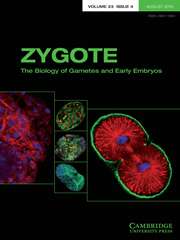Article contents
ZP3 and AIPL1 participate in GVBD of mouse oocytes by affecting the nuclear membrane localization and maturation of farnesylated prelamin A
Published online by Cambridge University Press: 19 December 2022
Summary
The low maturation rate of oocytes is an important reason for female infertility and failure of assisted pregnancy. The germinal vesicle breakdown (GVBD) is a landmark event of oocyte maturation. In our previous studies, we found that zona pellucida 3 (ZP3) was strongly concentrated in the nuclear region of germinal vesicle (GV) oocytes and interacted with aryl hydrocarbon receptor-interacting protein-like 1 (AIPL1) and lamin A to promote GVBD. In the current study, we found that lamin A is mainly concentrated in the nuclear membrane. When ZP3 is knocked down, lamin A will be partially transferred to the nucleus of oocytes. The prelamin A is increased in both the nuclear membrane and nucleus, while phosphorylated lamin A (p-lamin A) is significantly reduced. AIPL1 was also proved to accumulate in the GV region of oocytes, and ZP3 deletion can significantly inhibit the aggregation of AIPL1 in the nuclear region. Similar to ZP3 knockdown, the absence of AIPL1 resulted in a decrease in the occurrence of GVBD, an increase in the amount of prelamin A, and a significant decrease in p-lamin A in oocytes developed in vitro. Finally, we propose the hypothesis that ZP3 can stabilize farnesylated prelamin A on the nuclear membrane of AIPL1, and promote its further processing into mature lamin A, therefore promoting the occurrence of GVBD. This study may be an important supplement for the mechanism of oocyte meiotic resumption and provide new diagnostic targets and treatment clues for infertility patients with oocyte maturation disorder.
Information
- Type
- Research Article
- Information
- Copyright
- © Zhejiang Provincial People’s Hospital (Affiliated People’s Hospital, Hangzhou Medical College), 2022. Published by Cambridge University Press
Footnotes
These authors contributed equally to this work.
References
- 2
- Cited by


